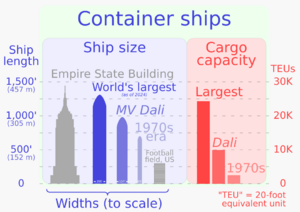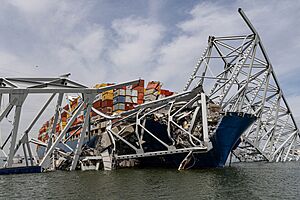Francis Scott Key Bridge collapse facts for kids
Quick facts for kids 
Dali under one of the collapsed segments of the bridge
|
|
| Date | March 26, 2024 |
|---|---|
| Time | 1:28:49 a.m. EDT (05:28:49 UTC) |
| Location | Baltimore metropolitan area, Maryland, United States |
| Type | Bridge collapse |
| Cause | Loss of propulsion on ship, leading to allision with pier and subsequent collapse of the bridge truss |
| Deaths | 6 |
| Non-fatal injuries | 2+ |
| Property damage |
|
On March 26, 2024, a large container ship named Dali hit the Francis Scott Key Bridge in Baltimore, Maryland. This happened very early in the morning, around 1:28 a.m. The ship struck one of the bridge's main support structures, called a pier.
Within seconds, large parts of the bridge collapsed into the Patapsco River. Six construction workers who were fixing potholes on the bridge were killed. Two other people were rescued from the water.
The collapse blocked the main shipping route to and from the Port of Baltimore. This port is very important for trade in the United States. Maryland's Governor, Wes Moore, said the event was a "global crisis." It affected many jobs and caused an estimated $15 million loss each day. Officials plan to rebuild the bridge by fall 2028.
Contents
About the Bridge and Ship
The Francis Scott Key Bridge was a long steel bridge. It was the second-longest of its kind in the United States. The bridge opened in 1977 and was about 1.6 miles (2.6 km) long. It carried Interstate 695, a busy highway around Baltimore. About 34,000 vehicles, including many trucks, used the bridge every day.
The bridge crossed the lower Patapsco River. This river connects the Port of Baltimore to the Chesapeake Bay and the Atlantic Ocean. The Port of Baltimore is a very busy place. In 2023, it handled millions of tons of cargo, including many cars and trucks. It also supported thousands of jobs.
The ship involved, Dali, is a container ship from Singapore. It was built in 2015. Dali is about 984 feet (300 meters) long. Before the accident, Dali had been inspected many times and had no major problems. In March 2024, the ship had 20 crew members from India and one from Sri Lanka.
When the bridge was built in 1977, ships were much smaller. Over the years, the Panama Canal was made wider, allowing much larger ships to pass through. This meant bigger ships, like Dali, started coming to ports like Baltimore. Dali was carrying about 4,700 large containers when it hit the bridge.
Some experts noted that the bridge's supports were not designed for collisions with such huge modern ships. Older bridges like the Key Bridge were often exempt from newer safety rules. These rules require stronger protection systems around bridge piers.
The Collapse Event
Dali left the Port of Baltimore at 12:44 a.m. on March 26, 2024. It was heading to Sri Lanka. Two local harbor pilots were guiding the ship. At 1:24 a.m., the ship suddenly lost all its power. This caused a "complete blackout." The ship started to drift out of the shipping channel.
At 1:27 a.m., the ship's crew made a mayday call. They warned the Maryland Department of Transportation that they had lost control and might hit the bridge. One of the pilots quickly asked for traffic to be stopped on the bridge. Police officers were able to stop traffic on one side of the bridge very quickly. Traffic on the other side was stopped just as the bridge collapsed. The ship also dropped its anchor as an emergency step.
At 1:28:45 a.m., the ship hit a main support pier of the bridge. The ship was moving at about 8 miles per hour (13 km/h) at the time.
Within seconds of the impact, the bridge broke apart. Sections of the bridge fell into the water. The main part of the bridge fell onto the front of the ship. Videos captured the moment the bridge collapsed.
Several vehicles were on the bridge when it fell. Workers were repairing potholes and were in their vehicles on a break. People living nearby said they heard a deep rumbling sound that felt like an earthquake.
Emergency teams received 911 calls right away. Large rescue efforts began, with boats, helicopters, and divers searching for people in the river.
Timeline of Events
This is a simple timeline of what happened, based on official reports:
| Time (a.m. EDT) |
Event |
|---|---|
| 00:39 | Dali leaves the Seagirt Marine Terminal |
| 01:07 | Dali enters the Fort McHenry Channel |
| 01:24:32 | The lights go out on Dali |
| 01:24:59 | Total power failure; ship loses power to move. Alarms sound. |
| 01:25:31 | The lights on Dali come back on |
| 01:25:40 | Black smoke starts coming from Dali's funnel |
| 01:26:37 | The lights go out again on Dali |
| 01:26:39 | Pilot asks for tugboat help (first sign of trouble) |
| 01:27:04 | Pilot orders the ship's anchor to be dropped |
| 01:27:09 | The lights on Dali come back on again |
| 01:27:25 | Pilot sends a VHF mayday call, reporting total blackout and that Dali was heading for the bridge (second warning) |
| 01:27:53 | Police are told to close the bridge |
| 01:28:09 | Last moving vehicle leaves the bridge |
| 01:28:49 | Dali hits the bridge at about 7 miles per hour (11 km/h) |
| 01:29:27 | Police report the bridge has collapsed |
| 01:29:39 | Pilot reports the bridge collapse |
| 01:29:51 | All roads leading to the bridge are shut down |
Damage Caused
The bridge was designed so that if one main support failed, the whole structure could collapse. This is called "fracture critical." When Dali hit the pier, it destroyed that support. This caused the other sections to fall quickly, within about 30 seconds.
The ship Dali was also damaged. Its hull was hit above the water line. Parts of the bridge, weighing thousands of tons, landed on the ship. This pushed the ship against the riverbed. Some containers on the ship were damaged, and two fell into the water. These two did not carry dangerous materials. However, a small amount of oil leaked from the ship. Authorities also found that some containers on board carried hazardous materials like corrosive liquids and lithium batteries.
People Affected
The water temperature was about 47°F (8°C) at the time of the collapse. Two people were rescued from the river. One was seriously hurt, and the other was not injured.
Six construction workers were reported missing and were sadly presumed dead. Their bodies were later found underwater. They were from Mexico, Guatemala, and Honduras. The last body was found on May 7.
The crew of Dali and the two pilots were not seriously hurt. One crew member had a minor injury. The crew stayed on the ship for a long time after the accident.
The Investigation
The National Transportation Safety Board (NTSB) started a full investigation. They sent a team to the site. The Federal Bureau of Investigation (FBI) also joined, but they said there was no sign of terrorism.
Investigators looked at the ship's "black box," called a voyage data recorder (VDR). This helped them create a timeline of what happened. They are looking into why the ship lost power. This includes checking the ship's electrical system and its design.
On April 15, FBI agents searched Dali. They were looking into whether the crew knew about any problems with the ship's systems before leaving port. The FBI is investigating if any rules were broken that led to the deaths.
A preliminary report from the NTSB was released on May 14. It said the ship had two power outages while it was in port before the accident. One happened when an engine part was accidentally closed. The other happened because of low fuel pressure. The report said the investigation into the electrical system was still going on.
Impact of the Collapse
The bridge collapse blocked almost all shipping to and from the Port of Baltimore. About 30 ships were heading to the port, and more than 40 were stuck inside. Only one part of the port, the Tradepoint Atlantic terminal, was still open.
Maryland's governor declared a state of emergency. All shipping to and from the Port of Baltimore was stopped. This caused big problems for businesses that rely on the port. Many shipping companies had to send their ships to other ports. Car companies like Stellantis, General Motors, and Toyota had to change their shipping plans.
Economists said the port closure probably wouldn't slow down the entire U.S. economy. However, it was costing about $1.7 billion per week in supply chain problems. Other states like New York and New Jersey offered their ports to help.
Local Effects
The collapse also caused major traffic problems. The main highway, I-695, was closed where the bridge used to be. Most traffic had to use other tunnels or go around the entire city of Baltimore. Trucks carrying dangerous materials had to take very long detours.
Cruise ships that were supposed to go to Baltimore had to dock in other cities, like Norfolk, Virginia. Passengers then had to take buses back to Maryland.
The governor said that 8,000 jobs could be affected by the bridge's collapse. The Small Business Administration offered low-interest loans to help small businesses hurt by the disaster. The Maryland government also passed a law to help port employees who lost their jobs and to support local businesses.
Legal and Financial Issues
Experts believe the cost of the damage and related losses could be very high, possibly billions of dollars. This could be one of the largest marine insurance losses ever.
The companies that owned and operated Dali asked a court to limit how much they would have to pay in damages. They want to limit it to about $43.6 million. However, the city of Baltimore and other groups are suing them. They claim the ship was not safe or that the crew was not skilled enough. If this is proven, it could affect the ship's insurance.
The bridge's insurance company is expected to pay Maryland's government $350 million for the damage.
See also
- List of bridge failures
- Tasman Bridge disaster – a similar incident in Australia in 1975
- Almö Bridge collapse – a similar incident in Sweden in 1980
Images for kids















